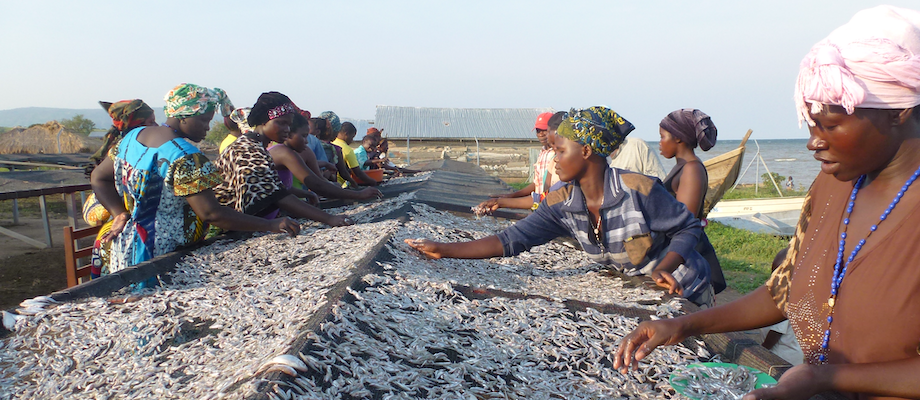Improved post-harvest practices for fish loss and waste reduction
By Patrick Kimani, FAO Consultant
Food loss and waste (FLW) in fisheries occurs at all value chain stages, contributing to food insecurity as well as to reducing the incomes of value chain actors. Once dead, fish spoils rapidly from the point of harvest onwards. Effective chilling and handling under good hygienic conditions, or processing, to preserve the fish in the absence of a cold chain, for example; drying, salting and smoking are important ways of controlling spoilage and improving shelf-life.
There have been many initiatives that have directly or indirectly aimed to reduce FLW. Learning from past initiatives that have demonstrated a reduction in FLW could provide important guidance for future interventions and support the implementation of the Voluntary Guidelines for Securing Sustainable Small-Scale Fisheries (SSF Guidelines) available here that calls for measures to tackle post-harvest losses.
With this in mind, the FAO Fisheries and Aquaculture Division, under its SSF Umbrella Programme, with support from the NORAD “Empowering Women in SSF for Sustainable Food Systems”, reviewed and documented a variety of initiatives in Africa focussed on; i) infrastructure; ii) improved post-harvest technology; iii) value addition; and iv) access to finance, through a gender-transformative lens. The review is captured in a recent publication available here and here we introduce some of the key the findings.
Well-constructed and maintained infrastructure such as landing sites and market facilities are important in enabling producers to organize, handle, sell and store fish and fish products efficiently and to meet food safety and quality standards and hence reduce FLW. From the review, infrastructure displaying best practices were those with good design considerations and management measures in place. Good design features were observed where end users were involved in the design process for landing sites and processing facilities. Setting aside space for future expansion was also seen as a good design consideration. Good management considerations included documentation of roles and responsibilities of all players in maintenance of good hygiene practices as elaborated in Sanitary Standard Operating Procedures (SSOPs), establishment of local management committees with delegated power from government and the presence of a sustainable and adequate revenue base, to run operations efficiently.
Improved post-harvest technology is critical in maintenance of fish and fishery product quality, food safety and reduction in FLW. Two important improved low cost and simple post-harvest technologies were identified: locally constructed perforated plastic containers for handling small pelagic fish on-board and during transportation; and raised racks for drying small-pelagic fish. The two technologies have taken root around Lake Victoria and have potential to reduce FLW significantly. An important driver of their wide-scale uptake is the use of locally available materials for construction of these technologies.
Value addition is important in improving product quality, convenience in use and significant reduction in FLW. Typically value addition involves improving end-product quality through better hygiene, handling and processing practices and changing how fish is packaged and labelled. The boxes and racks mentioned above are hence linked to value addition. Typical value-added products identified from the best practice review include; smoked fish, powder from dried fish, smoked or dried shrimps; and fried, grilled, and dried ready-to-eat fish snacks. A few considerations were seen as important in enabling successful value addition. These include; availability of finances to purchase necessary equipment, and to facilitate access to infrastructure and services; affordable technology enabling wider reach by more processors; good fish handling practices at all levels as a prerequisite for value addition; appraisal of extension officers’ skills to facilitate delivery of training; product certification mechanisms and certification schemes designed for SSF processors to enhance market access.
Access to finance is a critical need across the entire fisheries value chain. Finance and investment are needed by women processors and traders for such things as equipment, working capital and meeting certification requirements. Several successful credit models for SSFs were founds. These include; government established loan facilities requiring minimal collateral and applicants own, in-kind contribution. The direct financing of fish processing businesses by banks and microfinance institutions, with adjusted repayment options coinciding with peak months of production as well as training on financial and business management to improve viability and ability to repay loans. Other useful models for the SSF sector appropriate for women beneficiaries are village banks and Village Savings and Loans Associations (VSLAs) schemes.
Future activities will focus on packaging the learning from the review into capacity building materials and activities so these important findings can reach a wide audience and stimulate change to bring about improvements in fish quality, livelihoods of SSF actors and in FLW reduction.
Learn more about post-harvest practices here.

